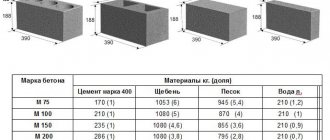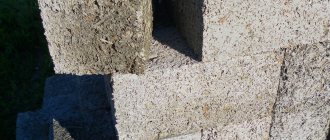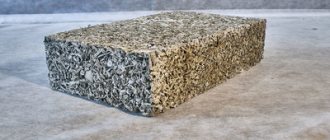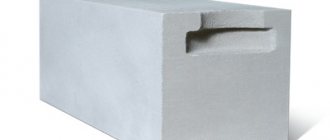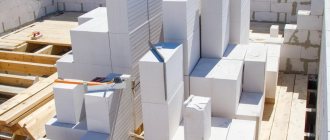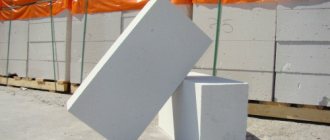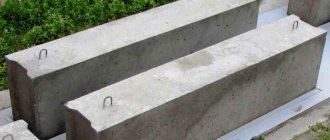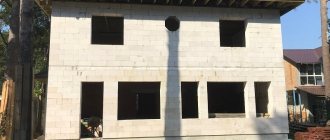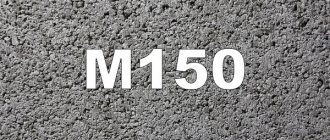Recently, the construction of houses and other buildings from block material has become widespread.
One of these materials is expanded clay concrete, which is produced on the basis of cement, sand and filler with water. Expanded clay acts as a filler.
Such raw materials interact well with different types of finishing, which is why both main and internal walls are often built from it. The mass of expanded clay concrete is influenced by several factors that you need to know about.
Weight of a high-quality expanded clay concrete block
All expanded clay concrete blocks are divided into two main types:
Despite the fact that the weight of a expanded clay concrete block varies widely among different manufacturers, there are still conscientious ones among them who adhere to the production technology, and we will be guided by them when determining the mass.
By the way, you can read about the calculation of expanded clay concrete blocks for a house in one of my previous articles. There is also an example of calculation, including gables and partitions.
Table of weights and other characteristics of blocks
| Block type | Strength grade | Weight, kg | Density, kg/m 3 | Thermal conductivity, W/m 0 C | Frost resistance |
| Hollow _ | M35 | 11 | 750 | 0,24 | F25 |
| M50 | 12 | 850 | 0,28 | F35 | |
| M75 | 14 | 1000 | 0,35 | F35 | |
| M100 | 16 | 1100 | 0,39 | F50 | |
| Full- bodied | M75 | 18 | 1300 | 0,54 | F35 |
| M100 | 19 | 1400 | 0,57 | F35 |
It is worth noting that all data in the table are averaged and refer to fully dried blocks measuring 390x190x188mm. In reality, the weight of expanded clay concrete blocks will vary slightly upward due to the presence of moisture inside it.
If you want to find out how many expanded clay concrete blocks are in 1 m 3, as well as calculation methods, then I advise you to read my article on this topic.
Number of voids
There are different types of voids that make up blocks. Pores also affect the mass and strength of the building material. For example, if you decide to use an expanded clay block, the porosity of which is 30 percent of the volumetric weight, then its frozen mass will be 18 kilograms. With a porosity of 40 percent of the volumetric indicator, when frozen it will be 16 kilograms.
Return to contents
Expanded clay concrete: Weight Brands Density Price
See also: Screed with expanded clay
Expanded clay concrete is divided into 3 main types:
- Thermal insulating expanded clay concrete
- Structural expanded clay concrete
- Structural thermal insulation expanded clay concrete
Brands of Expanded Dite Concrete Concrete class and its price:
- Brand M50 Concrete class B3.5 Price 3100 per 1 cubic meter
- Brand M100 Concrete class B7.5 Price 3500 per 1 cubic meter
- Brand M150 Concrete class B12.5 Price 3750 per 1 cubic meter
- Brand M200 Concrete class B15 Price 3850 per 1 cubic meter
- Brand M250 Concrete class B17.5 Price 3850 per 1 cubic meter
Related articles: Density of expanded clay concrete kg m3
Expanded clay concrete blocks 1m3 and their price:
- Hollow block 390*280*188 - price 3100 rubles per 1 cubic meter (48 pieces per cubic meter)
- Hollow block 390*250*188 - price 3100 rubles per 1m3 (54 pieces per 1m3)
- Partition block 290*90*188 hollow - price 3100 rubles (144 pieces per 1m3)
- Block 390*190*188 solid - price 3700 RUR (72 pieces per 1m3)
See also: Calculation of reinforcement
Expanded clay concrete weight 1 m3
This type of expanded clay concrete should not provide high reliability and strength; its low weight is ensured by the weight of expanded clay and its quantity.
The weight of 1m3 of expanded clay concrete starts from 350 kg (thermal insulation) and reaches 1800 kg (structural)
Related articles: Correct blind area
Thermal insulating expanded clay concrete
Thermal insulating and structural expanded clay concrete
Thermal insulating and structural expanded clay concrete comes in the following grades:
Volumetric weight starts from 700 and reaches 1400 kg/m3
See also: Concrete in winter
Structural expanded clay concrete
Also quite often, when producing expanded clay concrete, expanded clay aggregate and quartz sand are added, without adding expanded clay sand.
Kawabanga! Concrete reinforcement
As a binder in the production of expanded clay concrete, Portland cement of grade 400 and higher is used, with a minimum content of pozzolanizing, as well as slag Portland cement.
The weight of expanded clay concrete depends on the degree of porosity of expanded clay and its content in concrete. The weight of a block of 200 by 200 by 400 expanded clay concrete can be from 6 and reach up to 29 kg.
Weight of expanded clay concrete in 1 m3, rules for calculating weight, video
The concept of specific and volumetric gravity, methods of determination
The larger the expanded clay fraction in expanded clay concrete, the lower the weight of the mixture. The less expanded clay and more cement in the mixture, the heavier the concrete.
More information about the weight of expanded clay concrete
The larger the fraction of expanded clay gravel that is part of expanded clay concrete, the lower the weight of the mixture. The less cement in expanded clay concrete, the less weight of the mixture. The industry produces expanded clay concrete weighing from 350 to 1800 kg/m3.
Conclusion
One of the main advantages of concrete based on expanded clay is the ability to produce material for various purposes, from thermal insulation to wall. Using this approach allows you to significantly save on the purchase of building materials.
Related materials:
Quadruple options
The most popular hollow blocks are four-slot. Another name for them is standard. The average weight of such a brick is 15 kg, but the range is from 11 to 20 kg. This begs the question: why do parts of equal dimensions have different weights? The main reasons are the difference in manufacturing technologies and the dishonesty of manufacturers. Some artisanal companies replace expanded clay with dolomite or brick chips, which are much heavier.
The regions producing such products are Tatarstan, Moscow region, Udmurtia, Sverdlovsk, Saratov, Bashkiria and Khabarovsk Territory.
Features of the use of expanded clay concrete
Today, expanded clay concrete is widely used in construction, including in the construction of private houses.
But at the same time, due to its characteristics, it has some limitations in application. In order to answer the question - where expanded clay concrete can be used and where it cannot, it is enough to take into account its features:
Summarizing all the features, we can say that the use of expanded clay concrete is, first of all, limited to places where precipitation does not reach. If precipitation is inevitable, then good waterproofing of this material is necessary.
Given its lightness, it is perfect for floors and lintels (with proper reinforcement), where there are no extreme loads, and low thermal conductivity will allow expanded clay concrete walls to retain heat in the house in cold times.
Attention! In no case should you use expanded clay concrete instead of ordinary concrete to construct any type of foundation below ground level, even if large loads from the walls of the house are not expected. Such a foundation, even with good waterproofing, cannot be called reliable.
Well, as for the pros and cons of expanded clay concrete as a building material, this is the topic of a separate article.
Calculation example
The dimensions and weight of the block are given: 390x280x188mm, 5 slots; 18 kg.
- Finding the volume of the entire block
0.39 x 0.28 x 0.188 = 0.02 m3.
- Finding the volume of voids (cracks)
Let’s assume that the length of one slot is 140 mm, the width is 25 mm, and the depth is 175 mm.
0.14 x 0.025 x 0.18 x 5 = 0.003 m3.
- Finding the volume of expanded clay concrete
0.02 – 0.003 = 0.017 m3.
- Finding the block density
18: 0.017 = 1059 kg per m3 (it is often said that this is the specific gravity of expanded clay concrete in kg per m3).
Therefore, the weight of expanded clay concrete in 1 m3 is 1000 - 2000 kg, compared to aerated blocks, 1 m3 of which will weigh from 500 kg. The volumetric weight of expanded clay concrete, for example, grade 200, will not exceed 1800 kg per m3.
- Application area
- Recipe specifics
- Varieties
- Characteristics
- Conclusion
The insignificant weight of expanded clay concrete m3 contributed to the growing popularity of such products in construction
Three-slit and multi-hollow products
The weight of three-slit blocks ranges from 10 to 17.5 kg. They are manufactured in Astrakhan, Moscow and Tambov regions, as well as in Khabarovsk and Krasnodar territories.
To compare four-hollow and three-hollow blocks for durability and thermal conductivity, you will have to calculate the volumetric weight. The best option would be products weighing from 13 to 15 kg. It is within these limits that strength and thermal insulation are combined. Bricks that are too light will not be warm enough, and heavy bricks must be additionally insulated.
Recipe specifics
The basis of the expanded clay block is a cement-sand composition and expanded clay, which has a spherical shape. The aggregate is obtained from clay fired at a high temperature. The concentration of expanded clay in the mass determines how much the expanded clay concrete block weighs and what its strength is.
The array consists of the following ingredients:
- Filler in the form of expanded clay with a particle size of up to 1 centimeter.
- Fine sand.
- Portland cement.
- Water.
In the manufacture of expanded clay blocks, a number of main ingredients are used, including expanded clay, construction sand, cement mixture, and water.
Manufacturing process
The first stage is the preparation of all the required components, including cement, expanded clay, water, and fillers. All these components are poured into a concrete mixer in selected proportions, after which they are thoroughly mixed for 2-3 minutes. In this case, cement is the main binder. The thermal conductivity of expanded clay concrete blocks and their other parameters, which will be obtained at the output, depend on the ratio of the proportions of all these substances.
The second stage requires the use of a vibrating machine to shape the material. In order to carry out this process, a steel plate is placed in a special recess of the required dimensions, onto which the solution is poured. After this, the mixture is compacted using a machine.
The third and final stage of the manufacturing process is drying the already compacted mixture. Concrete blocks remain in special plates, in which they dry for two days. After this period, the plates are removed and drying continues, but in the open air. To do this, you need to leave them for another 8 days. The result of these actions is an expanded clay concrete block. Thermal conductivity is not the only advantage; in addition to it, there are a number of other qualities:
- frost resistance is more than 25 cycles, which is quite a lot;
- moisture absorption is quite low - less than 20%;
- good level of thermal insulation and sound insulation;
- high strength and complete environmental friendliness of the material;
- light weight and long service life;
- The price-quality ratio is quite acceptable.
Characteristics
Correct analysis of the parameters of expanded clay concrete products will allow you to purchase high-quality building materials to solve specific construction problems
Unscrupulous manufacturers, using low-quality raw materials, violating technology, are trying to reduce costs associated with production. They offer customers blocks called expanded clay concrete, but differing in performance characteristics.
Product quality indicators are characterized by the following characteristics:
The use of laboratory control methods makes it possible to accurately determine these characteristics. The ability to control parameters using special equipment is not always available.
Increased weight indicates a violation of the technology, recipe, or the use of low-quality filler mixed with heavy screenings or brick waste. A building made from such expanded clay concrete blocks will be cold and have reduced strength.
Weight of expanded clay concrete block 400x200x200 according to GOST
- frost resistance – F-35 – F-50;
- thermal conductivity – 0.19 W/m*°C;
- compressive strength – 65kg/cm2;
- shrinkage – 0%;
- water absorption - 50%.
The construction of country houses, garages, sheds, and outbuildings is not complete without the use of wall stone. The variety of shapes and textures allows it to be used for decorating architectural structures.
Due to their light weight, expanded clay concrete blocks can be used in monolithic construction as filler for the frame.
However, experts do not recommend using it when laying a foundation due to its fragility.
Types of expanded clay concrete
Wall stones are divided into two types depending on the mass and are:
According to their intended purpose, expanded clay blocks are also divided into two types:
Date: December 17, 2018
How much does an expanded clay concrete block weigh?
The insignificant weight of expanded clay concrete m3 contributed to the growing popularity of such products in construction
Application area
The scope of use of expanded clay concrete blocks is related to the purpose of the products. They are divided into the following types:
- Blocks used for the construction of partitions.
- Products used for the construction of capital and internal walls.
Expanded clay block is used when performing construction work related to the construction of:
- structures that can withstand increased loads;
- outbuildings;
- industrial facilities;
- partitions that perform soundproofing functions;
- premises for vehicles;
- monolithic structures.
When deciding to use expanded clay-based composite concrete, pay attention to the weight of the expanded clay block associated with the correctly selected composition of the material. The weight of one block depends on the design features and ranges from 5.1-34.3 kg.
The construction industry is constantly evolving: new technologies, materials and methods are being introduced to make work easier
Recipe specifics
The basis of the expanded clay block is a cement-sand composition and expanded clay, which has a spherical shape. The aggregate is obtained from clay fired at a high temperature. The concentration of expanded clay in the mass determines how much the expanded clay concrete block weighs and what its strength is.
The array consists of the following ingredients:
- Filler in the form of expanded clay with a particle size of up to 1 centimeter.
- Fine sand.
- Portland cement.
- Water.
In the manufacture of expanded clay blocks, a number of main ingredients are used, including expanded clay, construction sand, cement mixture, and water.
Varieties
Depending on the design features (presence of cavities), expanded clay concrete blocks are manufactured in the following options:
Characteristics
Correct analysis of the parameters of expanded clay concrete products will allow you to purchase high-quality building materials to solve specific construction problems
Unscrupulous manufacturers, using low-quality raw materials, violating technology, are trying to reduce costs associated with production. They offer customers blocks called expanded clay concrete, but differing in performance characteristics.
Product quality indicators are characterized by the following characteristics:
The use of laboratory control methods makes it possible to accurately determine these characteristics. The ability to control parameters using special equipment is not always available.
Increased weight indicates a violation of the technology, recipe, or the use of low-quality filler mixed with heavy screenings or brick waste. A building made from such expanded clay concrete blocks will be cold and have reduced strength.
Conclusion
Originally posted 2017-01-21 08:17:48.
Double-hollow, solid and partition elements
For non-residential light buildings, double-slit blocks with a high hollowness coefficient are most often used.
With their help, garages, sheds, cellars, etc. are erected. The Cheboksary Construction Plant even produces blocks for fences. The voids in them are quite large, reaching a size of 13x15 cm. Weight varies from 9 to 13 kg. The most reliable type of expanded clay concrete is monolithic blocks. They are used for buildings with high requirements for the reliability of walls. They are also used when installing a suspended facade or powerful gates.
Manufacturers mainly sell parts weighing 17-21 kg. If the mass exceeds the specified mark, then most likely it is not expanded clay, but blocks of sand and cement.
For the manufacture of partitions and the construction of small buildings, partition materials with dimensions of 400x200x90 and 400x200x120 mm are used. In addition, they can be used in conjunction with load-bearing blocks, resulting in a wall 30-50 cm thick. Partition options also have different designs:
- blocks 400x200x90 weighing 4.5-9 kg for hollow ones and 7-9 kg for solid ones;
- products 400x200x120 weighing 8-10 for hollow ones and up to 12.5 for solid ones.
The weight of bricks made with cement, sand, water and expanded clay is a very important property that characterizes various indicators. The coincidence of the actual weight of the product with that indicated in the directory guarantees a reliable purchase that will provide the structure with warmth and strength.
How much does an expanded clay concrete block weigh? | Weight of building materials
Due to the fact that in addition to the main characteristics of expanded clay concrete, including the size of the aggregate fraction, the weight of the block also depends on the number of voids. The easiest way to determine the weight of an expanded clay concrete block is to follow the manufacturers’ tables.
Table Weight of expanded clay concrete blocks depending on size and hollowness
Type of expanded clay concrete blocks
Name of expanded clay concrete blocks
Product code
Weight of one block
(kg)
Dimensions of expanded clay concrete block
Varieties
Depending on the design features (presence of cavities), expanded clay concrete blocks are manufactured in the following options:
- Solid, which are characterized by increased strength indicators and a dense structure of a solid mass. The one-piece design prevents the formation of fungi and mold. The weight is up to 26 kilograms depending on the size, and the specific gravity is about 1.5 t/m3.
- Hollow, having blind or through cavities, characterized by low weight. The weight of an expanded clay concrete block measuring 390x190x188 is 12-17 kg. This depends on the number and shape of the cavities.
Depending on the features of the technological equipment used, products from different manufacturers may differ in size. In particular, products with dimensions of 390x190x188 from different product suppliers may have deviations and be 390x190x190. In addition, the standard sizes of expanded clay concrete blocks are often rounded in conversation to round numbers, for example 200x200x400.
How to choose the best building material for your home
Which blocks are best for building a house? Sturdy, durable and warm
People usually think about a house made from building blocks because it is faster than using traditional building materials. Speed is speed, but quality characteristics are no less important. And to choose them correctly, here's what you need to know.
The cost of blocks for building a house also plays a significant role. The cheapest are polystyrene concrete and expanded clay concrete
As you can see, the list is considerable, but this information is necessary. Without them, there is no point in deciding which blocks are best for building a house. You simply won't have any criteria to choose from.
Lightweight concrete blocks for external and internal walls
The characteristics will show which blocks are better for building a house
Aerated concrete blocks
Which blocks are best for building a house? Consider the foam block
Advantages and disadvantages
Which gas block is best for building a house? Autoclaved aerated concrete
Aerated concrete is easy to process; it can even be sawed with a hand saw or grooves can be made with a metal strip. On the other hand, it is not so dense that you can hang heavy things on the walls without special fasteners.
Types and varieties of gas blocks
Aerated concrete blocks can be autoclaved or conventionally cured. For the construction of external walls, it is better to use an autoclave, as it has more stable characteristics. Such blocks are more expensive and they are better.
Aerated concrete can be made not only from cement and sand. Part of the cement is replaced with another binder. As a result, we get blocks made of another lightweight cellular concrete:
- lime + cement - silicate concrete;
- ground blast furnace slag + cement - slag-gas concrete;
- ash + cement + lime = ash concrete.
Types of building blocks: aerated blocks allow you to quickly build a warm house
Foam blocks for house construction
Foam concrete blocks are a good material for building a house. But only the quality is hard to track
Advantages and disadvantages of foam concrete blocks
Foam concrete blocks for building a house are a good choice. Provided that they are made strictly according to technology
More weight is not so good. This again means an increase in the size of the foundation and the need to have a helper for independent construction. Although if you compare it with the thickness of a brick wall, it is half as much. So the material is economical.
There is another consequence of thicker cement walls - it is more difficult to process. It can’t be compared with brick, of course, but it’s not too easy either.
Standard sized blocks cost relatively little. This is the cheapest of block materials
Polystyrene concrete blocks
What types of blocks are there for building a house on a budget? Polystyrene concrete - warm and inexpensive
To decide which blocks are best for building a house, we study the characteristics and properties
Disadvantages and features
The size of a polystyrene concrete building block is length from 60 cm, width from 20 cm, height from 20 cm. They can be twice as thick/higher
Expanded clay concrete blocks
In the last century, block construction of houses was carried out mainly from expanded clay concrete blocks
Advantages and disadvantages
Expanded clay concrete construction blocks have average thermal efficiency characteristics
Even if slotted blocks are used, the wall must be thick
Cinder blocks
Comparison of lightweight concrete blocks using different technologies and with different aggregates
Pressed cement blocks from sand concrete (besser blocks)
Which blocks are best for building a house? If strong walls are a priority, then vibropressed ones are beyond competition
Advantages and disadvantages of vibrocompressed blocks
Sand concrete blocks: main characteristics of solid ones
Which blocks are best for building a house? In beauty - these
Among the “pure” disadvantages are the rather large weight and small size of the stone. This is when compared with blocks made of lightweight concrete. Accordingly, a foundation for a large weight requires a more powerful one, which leads to an increase in its costs.
Heat block
Perhaps the most energy efficient option. It's just not very popular yet
Here the characteristics are not so difficult to find. Apparently, because thermal conductivity pleases
Appearance
Expanded clay concrete can have different dimensions and weight. Based on appearance and structure, this building material is divided into 4 types:
- facial details;
- ordinary blocks;
- whole products;
- hollow bricks.
Materials of the first group are excellent for installing external walls, because they have an attractive appearance and practically do not require further finishing.
Ordinary bricks need to be additionally processed and covered with decorative elements. Solid bricks are more suitable for multi-story construction. Fastening elements are perfectly screwed into them, which is why they can be actively used when arranging ventilated facades.
Hollow options are distinguished by their lightness, convenience and high thermal insulation, but they can only be used in the construction of small houses no more than two floors high.
